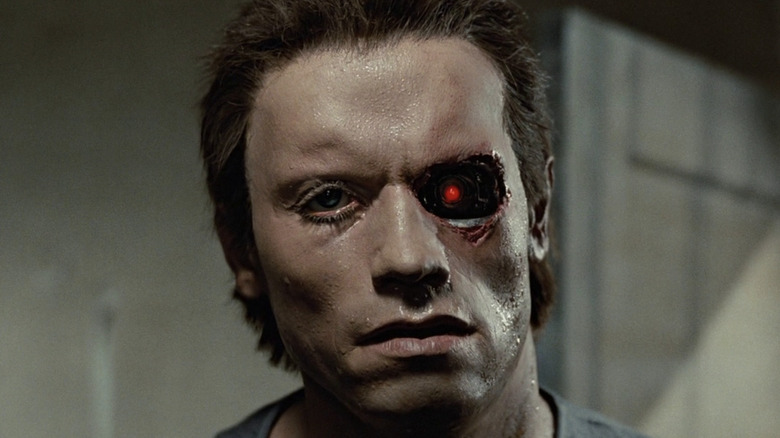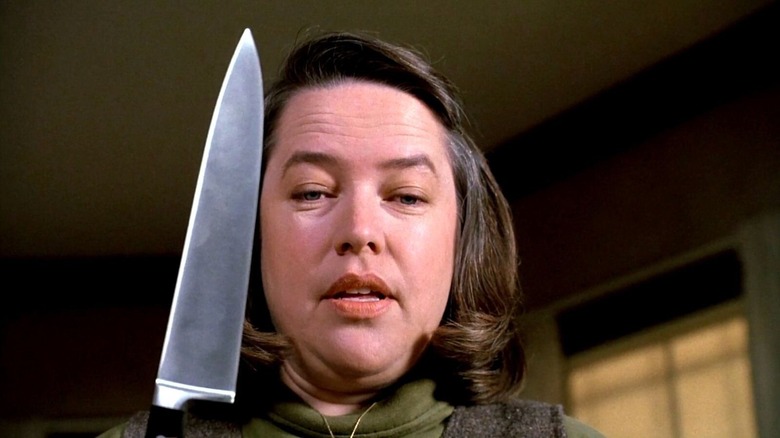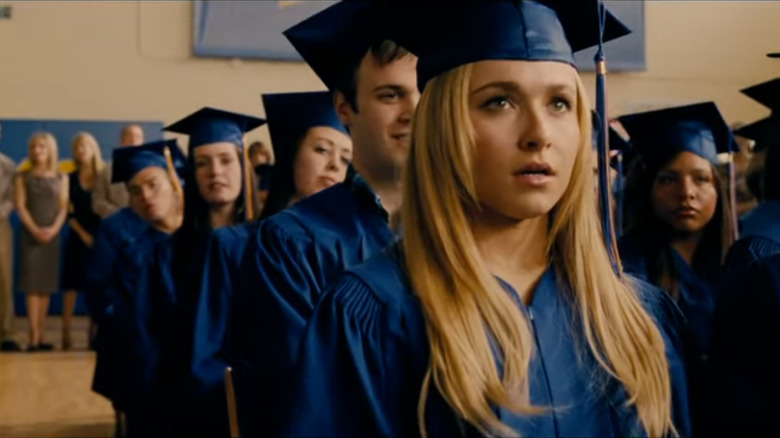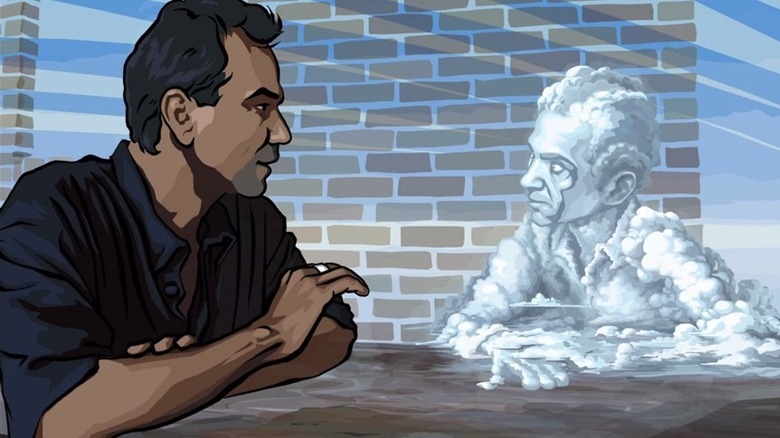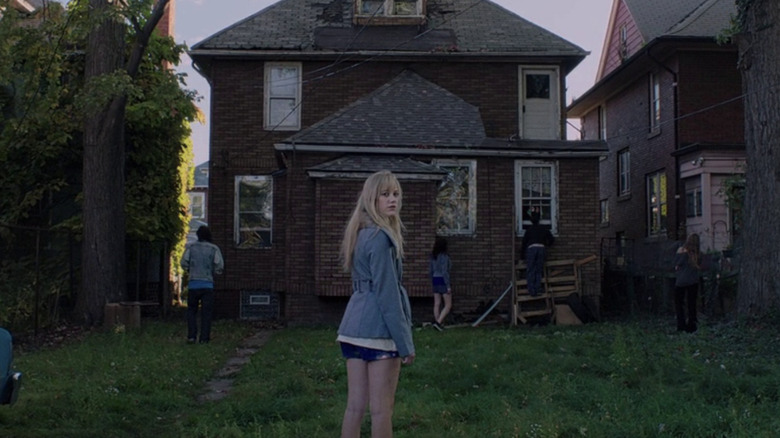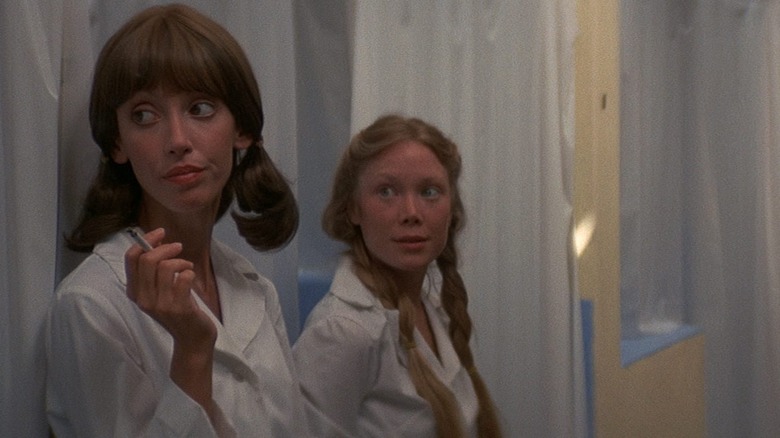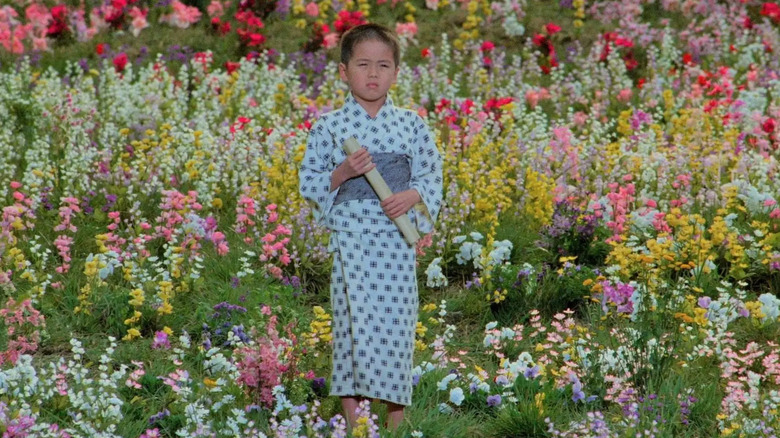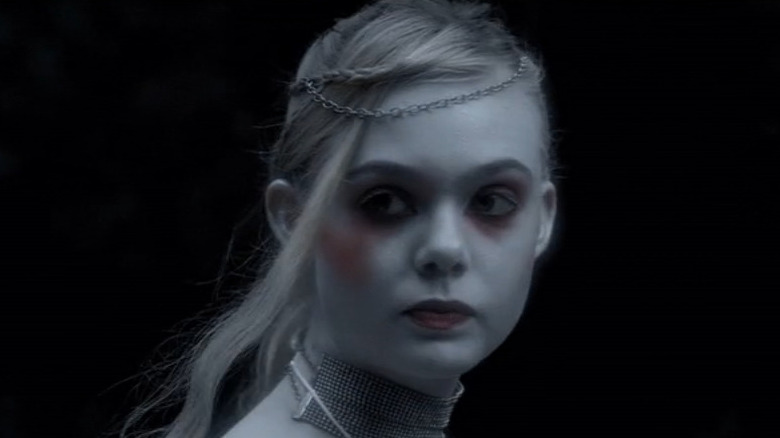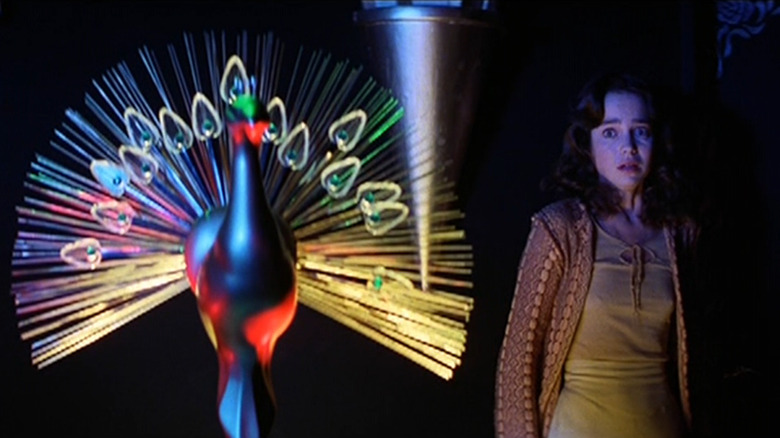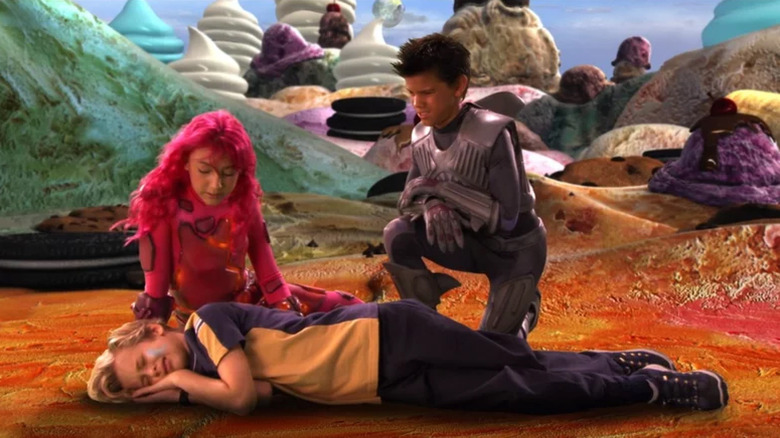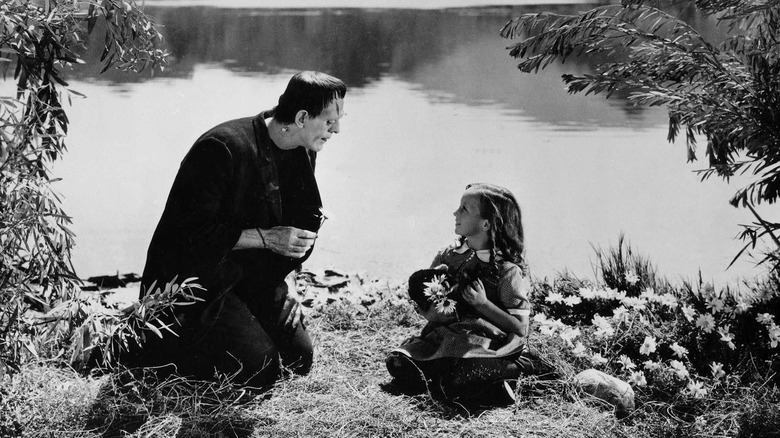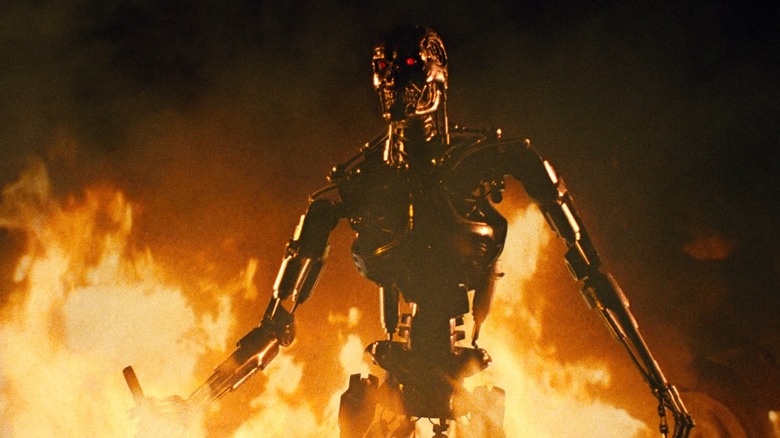Movies Whose Major Inspiration Came From A Dream
Arguably, all movies begin as a dream — at least metaphorically — as they're imaginative fantasies that come to life on-screen. But every once in a while, a dream literally inspires a film. A writer or director wakes up from a particularly vivid dream and thinks, "Y'know, that would make a great movie." While more often than not, we struggle to make sense of our dreams (particularly when telling them to someone else), there have been moments where these filmmakers have followed through on that impulse to make a movie based on a dream they had and even made something coherent from it (although not always).
So, we've assembled a collection of dreams and nightmares that, against all odds, became actual movies. For the most part, these dreamers are screenwriters and directors, but in a few cases of films that were adapted from novels, we're going to discuss authors as well. Most of these films are genuine classics, and not surprisingly, they tend to be on the surreal or even horrific side. That being said, there will also be a few stinkers mixed in here. You know that feeling when a friend is describing their dream to you, and your eyes start glazing over? Yeah, they're like that. So, read on to find out if any of your favorite films were actually inspired by a wild dream or nightmare someone once had.
Misery
The works of Steven King have produced some of the spookiest villains to ever appear on-screen, including Jack Torrance from "The Shining," Pennywise from "It," and the demonic car in "Christine." But the most sweetly and disarmingly vile just might Annie Wilkes, the hammer-swinging killer fangirl from the 1990 film "Misery." Kathy Bates won an Academy Award for her brilliant portrayal of this murderous nurse, which makes this film the only film adaptation of a King novel to ever win an Oscar to date. It's no surprise, since with her unique combination of cheery midwest disposition, impressive intellect, emotional volatility, and utter ruthlessness, Annie is quite unlike any other character King has written.
In his memoir "On Writing," Steven King recounts the story of how Annie Wilkes came to be. While on a flight to London, he fell asleep and had a dream about a writer, who became the prisoner of an obsessive fan. When he awoke, he scribbled down what he could remember of the dream on an American Airlines napkin. King writes, "She speaks earnestly but never quite makes eye contact. A big woman and solid all through; she is an absence of hiatus. (Whatever that means; remember, I had just woken up.)" He also wrote a single line of dialogue for the character, who named her pet pig after one of the dream writer's characters: "I wasn't trying to be funny in a mean way when I named my pig Misery, no sir. Please don't think that. No, I named her in the spirit of fan love, which is the purest love there is. You should be flattered."
Though that particular line didn't appear in the final film, it's still a perfect example of the sweetly haunting cadence of Annie Wilkes, which perhaps takes on a new quality of strangeness since we know she came from King's nightmare.
I Love You, Beth Cooper
In "I Love You, Beth Cooper," high school valedictorian Denis Cooperman has been tasked with giving his class's commencement speech, and he decides to go out with a bang. Not wanting to graduate with any regrets, he spends his time on stage openly ridiculing the classmates who bullied him and confessing his love to the girl of his dreams, Beth Cooper. That night, Denis has a graduation party, and to his surprise, Beth shows up, intrigued by this weird little dude whom she never noticed before. But unfortunately, the aforementioned bullies that Denis insulted soon show up as well, along with Beth's jealous boyfriend. Standard issue teen comedy hijinks ensue.
Believe it or not, this story about a romance between a boy and his dream girl has its origins in an actual dream, one that belonged to Larry Doyle, who wrote both the eponymous novel and its screenplay adaptation. In a blog post from 2007, Doyle recounts the origins of the film. Doyle writes, "in the fall of 2005, I had this dream: I'm giving my high school graduation speech, but I veer off text and declare my love for a girl I had a crush on in the Seventh Grade. That's an idea for movie, I thought."
He's certainly right about that, since it's one heck of premise. However, the final result was not a well-received film. Critics generally agree that, after this admittedly inspired opening, the rest of the film descends into a parade of forgettable comedy clichés. Sadly, it goes to show that a single good idea — even one that came from a dream — is not always enough to make an entire film.
Waking Life
In Richard Linklater's 2001 semi-animated film "Waking Life," an unnamed man played by Wiley Wiggins finds himself drifting through a series of surreal vignettes, which may or may not be dreams. He occasionally wakes up to what he believes is reality, only to discover yet another world that is no more real than where he was previously. He doesn't know how long he has been experiencing life this way or if this even is life, and he doesn't know how to escape. By the end of the film, we don't get definitive answers about exactly what is going on here, but the journey itself is a fascinating meditation on the meaning life and the nature of reality.
As decidedly un-real as the film may be, it is, in fact, based on a true story, or at the very least, a true dream that director Richard Linklater had. In an interview with PopMatters, Linklater states, "That really happened to me, it was a really formative lucid dream, like in the movie, that series of false awakenings. It seemed to go on for weeks and weeks, and got creepy near the end." We can only imagine how frightening and overwhelming it would have been to endure a seemingly endless dream like this for real. But given how powerful and, at times, profoundly unsettling the final film is, it seems like in this case, Linklater did an impressive job of translating the experience to the screen.
It Follows
One of the most subtly and quietly terrifying horror films ever crafted, "It Follows" tells the story of a teenage girl, who is being followed everywhere she goes by a monster. It can look like anyone, only she can see it, and it's very slow. But if it ever touches her, she dies. If this seems like an idea straight out of a nightmare, that's because it is.
In an interview with IndieWire, director David Robert Mitchell describes the origins of the film as follows: "The basic idea came from a recurring nightmare that I had when I was a kid in which I was followed by a monster that looked like different people. And only I could see it. And it was very slow and it was always walking toward me." Usually, when a film is inspired by a dream, it will just be a single idea, or a single image, that gets translated to the screen. In the case of "It Follows," however, it was basically the entire premise. The only part of the film's narrative that seemingly wasn't included in the original dream is how someone gets the curse in the first place, and how you pass it along to someone else. But given that Mitchell was a kid at the time, it's probably for the best that he didn't envision that part back then.
3 Women
It isn't often that a dream for a film comes complete with a cast, setting, and title, but that's just what happened to Robert Altman when he had the dream that inspired his surreal psychological drama "3 Women." In an interview with BFI, Altman describes how he dreamt up the movie while his wife was ill in the hospital: "I dreamed this film. I woke up and took the yellow pad next to my bed and wrote a sketch for 3 Women and went back to sleep. Then I dreamed more of it and woke to write some more. I cast it. Then I had two of the fellas that worked for me at the time came into the bedroom and I told them to go down to Palm Springs because we were going to shoot this in the desert ... Then I woke up. ... I hadn't written anything down, I didn't have a pad next to my bed. So I had dreamed the title, 3 Women, and this image of where it took place."
In the film that Altman ended up making, Shelley Duvall plays a woman named Mildred "Millie" Lammoreaux, a warm and chatty physical therapist working at a spa in the California desert. Sissy Spacek is one of her co-workers, a shy and mysterious new hire also named Mildred, though she goes by "Pinky." The two soon become fast friends, and their relationship primarily consists of Millie talking and Pinky listening. But after Pinky experiences a traumatic event, she starts behaving much more like Millie, and even starts asking people to refer to her by her real name of "Mildred." From there, things get even wilder.
Straddling the line between a traditional narrative and full-on experimental art film, "3 Women" accurately replicates that feeling of finding yourself inside a totally inscrutable — yet nonetheless captivating — dream. Upon waking, you'd never be able to explain to someone else why it's so compelling, but while it was happening, you were utterly enraptured.
Dreams
Akira Kurosawa is an unparalleled filmmaker, responsible for crafting a vast canon of classic and influential films. But there's one entry from late in his career that stands apart from the rest of his work: the 1990 film titled "Dreams." It was one of Kurosawa's last films, it was the first he had written entirely by himself in over 40 years, and it was also perhaps the director's only attempt at a true anthology (via Criterion).
"Dreams" tells a series of strange short stories, all based on the director's actual dreams, with some bits of classic Japanese folklore mixed in as well (via Criterion). One story follows a little boy who sneaks away from home into the forest, where he witnesses a kitsune wedding. Other segments are far grimmer and more politically pointed, such as one about the ghosts of soldiers from World War II, or another in which a nuclear holocaust has mutated humanity into demons. The most visually striking vignette features a man walking around through landscapes based on the paintings of Van Gogh, before he finally encounters the painter himself, played by — of all people — Martin Scorsese!
The end result is an undeniably beautiful film, full of haunting stories and breathtaking imagery. And even though it's not considered by most to be true top-tier Kurosawa, it's still a singular achievement in his filmography, and very much worth experiencing.
Twixt
Generally speaking, most dreams are only interesting to the person having them, and they don't actually make for very good stories to tell others. Given this, it was kind of inevitable that eventually, someone would try to make a film based on a dream, and they would end up creating an incoherent mess.
Francis Ford Coppola is a legendary filmmaker, who has made many films that are true masterpieces. His 2011 film "Twixt" is not one of them. It follows a horror novelist named Hall Baltimore, who arrives in a small town for a book signing. However, after learning of a gruesome murder that just occurred there, Hall decides to stay a while, with the idea that it might help to inspire his next novel. By night, Hall dreams of a colorless, ghostly version of the town, where he encounters a mysterious girl named "V." Hall continues to investigate the murder by day and experience haunting dreams by night, before eventually learning the truth of what's really going on in this sleepy little town.
Speaking on the origins of the film, Coppola says, "[It] grew out of dream I had last year — more of a nightmare ... But as I was having it I realized perhaps it was a gift, as I could make it as a story, perhaps a scary film, I thought even as I was dreaming" (via The New York Times). It's not entirely clear exactly what Coppola was going for with this one, but this is a case where whatever he feeling when he was asleep wasn't something he was able to translate into our waking world of sunlight and logic.
Suspiria
The entirety of the 1977 horror classic "Suspiria" certainly feels like a dream, with its odd architecture, vivid colors, and utterly baffling story. As such, it should not be surprising to learn that the film's climax was directly lifted from a dream, one that belonged to co-writer Daria Nicolodi.
The film's plot concerns a young ballerina named Suzy, who is admitted to the prestigious Tanz Dance Akademie in Germany. During her time there, she has a series of increasingly strange and terrifying experiences. Her instructors all behave in odd, inexplicable ways, she starts having strange dizzy spells, and unbeknownst to her, her fellow students are also being murdered by malevolent forces. As time goes on, Suzy starts to suspect that the women running the school might, in fact, be a coven of witches. Perhaps not surprisingly, things get really wild once we hit the finale.
In the making-of documentary "Suspiria 25th Anniversary," Nicolodi states that she once had a dream that she was in a room with an invisible witch and a panther, and the panther exploded. If you've seen "Suspiria," you know that this bizarre turn of events did indeed become the actual ending of the film. When our hero Suzy confronts the witch Helena Markos in the film's climax, the witch hides from Suzy by turning invisible. There is also a panther in the room, which does explode for no apparent reason. However, unlike in Nicolodi's original dream, it's just a porcelain panther. Because apparently, even for the makers of this film, you have to draw the weirdness line somewhere.
The Adventures of Sharkboy and Lavagirl
The 2005 film "The Adventures of Sharkboy and Lavagirl" is the story of a ten-year old boy named Max. Max doodles in his dream journal about a world called Planet Drool: a fantastical place, where his dreams are real, and which includes a pair of superhero protectors known as Sharkboy and Lavagirl. From here, you can probably guess where the plot is going. Max soon learns that Planet Drool is real, as are Sharkboy and Lavagirl, and they need his help to save their world.
What you might not be able to guess, however, is the fact that this story is based on the dreams of an actual little boy. The film opens with some text that reads, "Based on the stories and dreams of Racer Max." Racer Max Rodriguez is the son of the director, Robert Rodriguez. Most of the ideas in the film came from Racer, who even went to set to help his father fine-tune this children's fantasy (via The Sun Sentinel). Racer even got a "story by" credit on the film, despite only being seven-years-old at the time. The movie itself didn't end up being particularly well-received by critics, but hey, what did they expect from something dreamt up by a seven-year-old?
Frankenstein
It's a well-known fact that the classic 1931 horror film "Frankenstein" was adapted from Mary Shelley's 1818 novel by the same name. What's slightly less well-known, however, is that this novel was also an adaptation of sorts, inspired by one of Shelley's dreams.
The preface to the 1831 edition of the novel includes a telling of the story's origins in the author's own words. After a day of telling ghost stories with her husband Percy and Lord Byron, Shelley tried to sleep but was met with a half-awake vision of a "pale student of unhallowed arts kneeling beside the thing he had put together. I saw the hideous phantasm of a man stretched out, and then, on the working of some powerful engine, show signs of life, and stir with an uneasy, half vital motion."
Shelley continues, "Swift as light and as cheering was the idea that broke in upon me. 'I have found it! What terrified me will terrify others; and I need only describe the spectre which had haunted my midnight pillow.'" She couldn't have known how right she was, as "Frankenstein" has become one of the most influential stories of all time, and one that Hollywood has returned to repeatedly.
In recent years, astronomers have been able to pinpoint the exact night and hour that this fateful dream occurred, based on a combination of details from Shelley's story — such as the description of moonlight in her room — and modern astronomical data. So, we can be reasonably certain that Shelley had this fateful dream at right around 2:00 AM on June 16th, 1816.
The Terminator
Perhaps the most iconic moment from James Cameron's science fiction horror masterpiece "The Terminator" comes at the very end. Our heroes think they have defeated the relentless robotic assassin from the future. The truck he was driving has just exploded into a massive fireball. There's no way he survived. But then, a shape climbs out of the burning wreckage and starts walking towards them. It's the Terminator, with all traces of its human disguise burnt away, leaving behind a lumbering metal skeleton. It's an image that has no doubt haunted the dreams of viewers everywhere, but believe it or not, the first person to have this particular nightmare was James Cameron himself.
When Cameron was working on his first film — the much-maligned "Piranha II: The Spawning" — he got sick with a terrible illness. In a later interview with Entertainment Weekly, he recalls having a particularly vivid fever dream about "this metal death figure coming out of a fire. And the implication was that it had been stripped of its skin by the fire and exposed for what it really was."
It's an undeniably powerful image, so we can understand why Cameron felt so compelled to write a film around it. That being said, this is one case where, in retrospect, the dream was far from being a complete story on its own. The fact that Cameron was able to build an entire film franchise around this one surreal image is the part that's really impressive. It just goes to show that, for filmmakers everywhere, having a dream is just a starting point. The hard part is making it a reality.
